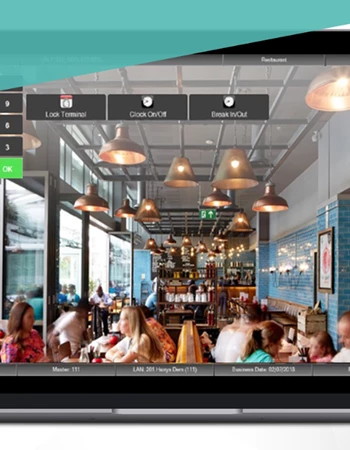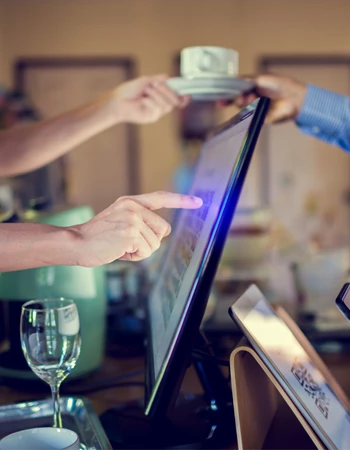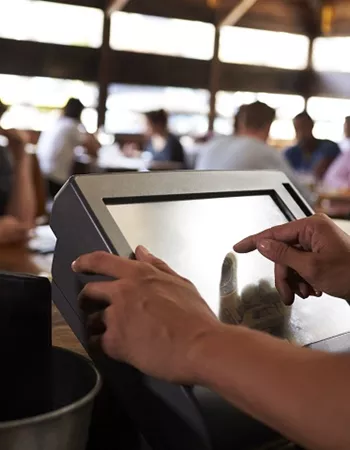
Switching EPoS systems: How to overcome challenges
If you’re here, then you’re probably thinking that it’s time to update your EPoS system. A daunting undertaking for any business in our opinion! The PoS system is the central point of your business that facilitates every single transaction. So, your new system needs to be ready to go, problem-free from day one. Sounds stressful! But the alternative could be holding back your business growth by struggling with a legacy system that’s well past its sell by date.
Our Senior EPoS specialist Mark Bagnall has over 30 years’ experience in consultation, installation and maintenance of EPoS solutions within the hospitality industry and has helped us identify the six biggest challenges our customers face when making the switch.
Find out how business operators can overcome them to make their EPoS system upgrade completely stress-free.
 8 mins
8 mins
Written by Mark Bagnall, senior EPoS specialist
What is a hospitality EPoS system?
A hospitality EPoS system is an essential IT tool for venues, providing seamless integration between different aspects of your business such as front and back-of-house teams, payment systems, stock systems, third-party apps, and HR systems. This integration ensures your customers have a frictionless ordering and payment experience.
A good EPoS system also helps to drive revenue through upselling prompts and rear display advertising. It offers real-time reporting on every transaction, allowing you to monitor your performance using customisable dashboards based on your business KPIs.
Your hospitality EPoS system should also provide stock result dashboards that enable you to manage purchase orders, recipe costings, deliveries, returns, transfers, and menu products. This helps you reduce waste and save operational costs.
To ensure your EPoS system is effective, it must be up-to-date, reliable, and provided by a trusted provider.
Benefits of using a hospitality EPoS system
Faster service
By using a hospitality EPoS system, you can improve the speed of service in your venue. A streamlined kitchen display system helps improve accuracy between the front and back-of-house teams, reducing the risk of errors and delays. Faster service means you can turn around more tables, serve more customers and increase your revenue.
Simple for customers
An easy-to-use and configurable digital system helps improve customer service and profitability. Automatic upselling prompts and product details can be displayed to customers at the right time, encouraging them to purchase more items. This system also simplifies the ordering process for customers, reducing wait times, and ensuring that they receive their orders quickly and accurately.
Support for all payment methods
A hospitality EPoS system provides seamless integration with all major payment methods, loyalty schemes, shopping platforms, and food delivery apps. This ensures that your customers can pay for their orders in the way that is most convenient for them. By supporting a variety of payment options, you can drive revenue through every available channel.
Real-time reporting
With real-time reporting, you can monitor performance as it happens. Sales are recorded instantly, allowing you to identify trends and make data-driven decisions. Defined key performance indicators can be reflected in your customisable reporting dashboards, giving you a clear understanding of how your business is performing and where improvements can be made.
Save money
A hospitality EPoS system can help you save money in several ways. Stock result dashboards enable you to manage purchase orders, recipe costings, deliveries, returns, and transfers. You can also adapt and manage your menu products to reduce waste and save operational costs. By improving the accuracy of your stock management, you can reduce waste and save money. Additionally, you can identify areas of your business where costs can be cut, allowing you to make smarter financial decisions.
When might it be time to switch EPoS providers
Outdated technology
If your current EPoS system is outdated and no longer meets your business needs, it may be time to switch providers. A cloud-based EPoS system is more easily updated to keep up with changing technology trends and accept new contactless payment methods. Similarly, being able to integrate with the newest third-party delivery, booking and loyalty platforms is essential.
Poor customer support
No business can afford to spend hours on hold when their EPoS system is experiencing issues in the middle of service. If your current provider is slow to respond or deal with issues or you experience a lot of issues with consistent service, it might be time to switch providers.
Limited functionality
If your current EPoS system is unable to support your business growth and expansion, it may be time to switch to a more scalable and flexible solution. As your business grows, you might need a more robust system to help with data reporting, connecting with wider systems and more.
Security concerns
If you have concerns about the security of your current EPoS system, it may be time to switch providers. A reputable provider should offer robust security features, such as encryption and secure payment processing, to protect your business and customer data.
Cost considerations
If you find that your current EPoS provider is no longer cost-effective, it may be time to switch. As your business grows you might find that a new supplier can offer a better price across multiple sites.
Slow service
Another sign that it may be time to switch EPoS providers is if your current system is affecting the customer experience with slow service. If your EPoS system is causing delays or errors in orders, it can lead to frustrated customers and lost revenue. Upgrading to a more modern and efficient system can help improve the speed and accuracy of your operations, resulting in happier customers and increased profitability.
Key challenges
We cover some of the key challenges when switching EPoS systems
Cost
You won’t be surprised to hear that the number one challenge for businesses changing EPoS systems is cost. And again, it will come as no surprise to you that switching is an expensive and a big decision.
There is a question that we should ask ourselves. What is the cost of doing nothing? We can calculate the cost of lost revenue from old terminals going down during a busy service or businesses outgrowing their EPoS system and losing out on new upselling or app integration revenue opportunities.
EPoS system implementation costs can also be offset by considering how current processes can be streamlined, how a single source of accurate data can minimise reporting inaccuracies, save time and reduce costs.
Many EPoS system provide flexible payment options for software and hardware to help you budget for the switch over an agreed term.
Your provider should also offer you support on managing your rollout plan to fit to your budgets. It maybe that you can stagger your rollout over an agreed timeframe and allocate budget accordingly.
Onboarding process
Switching EPoS systems is a huge undertaking, there’s no getting away from it. If you have decided that your business EPoS system needs changing, then you’ll need to fully embrace the onboarding process.
Set yourself up for success with senior level sponsors, an internal team made up of key representatives from each key department to help you bed in the new process and system e.g. site manager, stock manager, finance manager, a head office EPoS champion to really drive the transformation from within.
Change is good, but it’s a process that needs managing.
A new hospitality EPoS system is also an opportunity to introduce new business improvement initiatives like introducing new cash handling procedures or moving from monthly stock audits to weekly stock checks with daily line checks. All of these can contribute to a successful implementation and greater business efficiency.
Don’t forget to engage the frontline teams. Those who use the system day in, and day out need bringing on board from the moment the project has been given business and commercial approval. These are your experts and come with a wealth of experience you should leverage. Run group training sessions and group workshops prior to the new EPoS system being rolled out so they can learn, feedback and test the new system before it gets rolled out.
Resource
"I just don’t have the resource to deliver this" - sound familiar?
Choose a provider that can help you lead the and project manage the process, their experience will be key to landing a successful switch over to a new hospitality EPoS system.
Find a provider that will work as an extension to your team, provide you with a dedicated project team, set clear goals and project milestones from the outset that are agreed and documented with your business.
An example of this is when The Access Group rolled out to Access EPoS to Young's brewery with 150 plus sites successfully implemented in just 12 weeks. For such a large-scale project this was only possible with a dedicated project team in Access being pulled together who worked with Youngs to create clear project goals, milestones, an implementation plan, training workshops and physical roll out.
Your chosen provider should work with you on:
- Planning the project scope, goals and milestones
- Project management
- Installations
- Post deployment support
- Training /workshops
- Dedicated account manager to oversee the success
- 24-hour self-serve help and telephone Helpdesk for ongoing support and help
Integrations
Your hospitality EPoS system will be at the heart of your tech stack within your restaurant, bar, hotel or store. It will have multiple integration points to consider such as credit card, mobile apps including third party aggregators like UberEATS, Deliveroo and Just Eat, labour systems, people systems and stock systems. All these integrations may seem like a tangled web and too difficult to change.
An experienced provider will be able to help you manage that switch over and ensure integrations continue to fire with no disruptions.
A cloud-based EPoS system can also provide you with even limitless integrations with other software and apps helping to offer even better customer service and experience.
As an example, Access Hospitality EPoS offers an open API which allows you to integrate with over 80 major payment providers, mobile payment apps, loyalty schemes, order ahead and reservation booking systems giving customers a single touch experience which fulfils all their needs.
Too disruptive
An understandable challenge for switching EPoS systems is the disruption to your venue and operations as this is rolled out to live and working sites.
The deployment schedule can help overcome this by managing the project plan to factor in deployment in early mornings or late evenings. Late evenings are a good idea if you can as this gives you a clear 8-hour window to remove the old system and new system installed and tested before reopening.
In this scenario your providers installation teams arrive on site or multiple sites at closing. Technical engineers would be on site to remove the old hardware, install the new hardware, complete all the tests and be working and ready for the next morning when the sites open and trade.
Finding a reliable provider
Lots of choice can be overwhelming. Outline your needs and then do your research to find a shortlist of at least three providers. Speak to their current customers, go to venues, look at the equipment, speak to a manager.
It’s important to understand their hardware warranties, a good provider will be offering a minimum of 3 years, or some offer up to 5 years.
Check what service level agreements they have in place. What is their call out times and fix times to ensure you minimise your downtime and lost revenue.
Ask to see their 3, 6, 12-month product roadmap and understand how this is based on tech changes in the industry.
Ensure that software updates happen automatically to deliver the latest features and benefits without you having to think about it. Could-based EPoS systems run updates in the background so there are no service disruptions, and you are left with the reassurance that your business is as up to date as possible. Particularly important with payment partner updates so you won’t be in the position of not being able to support specific payments.
Next steps
Switching your hospitality EPoS system is a big commercial decision for your business but, ultimately one that can drive increased efficiency, save time, revenue growth, empower your team and provide an enhanced customer experience.
To recap, the potential challenges (and how to overcome them) are:
- Cost - This can be controlled by phased rollouts, payment plans, offsetting inefficient process costs and leveraging the upsell opportunities the system offers.
- Onboarding process - This can be overcome by building an internal team, getting a senior sponsor and engaging the frontline teams.
- Resource - Work with your provider to create the project plan, milestones and goals. Enlist their expertise in running training and workshops. Lean on your Account Manager to keep the project on track.
- Integrations - This is a software web of confusion that can be untangled. Your provider has experience and can lead you through the integrations process ensure you maximise new integration opportunities.
- Too disruptive - This can be avoided with a managed deployment plan with your provider, using venue close time to implement the hardware and software switch, in multiple sites, all in one go.
- Finding the right partner - Be clear in what you want and then research, research, research using as many sources as possible.
All these challenges can be overcome but your EPoS system provider is key to this success. If you’re ready to speak to someone you can contact one of our specialists here, to talk to us about your needs.
Three simple steps to take when switching to Access EPoS
1. Scope
Our EPoS consultants have been working with hospitality operators for decades and have always used a consultative approach, working together to identify the right set up for you and your business and where technology can help improve your processes. Within the scoping stage, we are also looking at your partner integrations to ensure they speak to each other.
2. Planning & implementation
The next step is to agree a project plan working with you to achieve the desired configuration that fits your internal operations and service style. Our team will help with product build and run through user acceptance testing to ensure you are happy with the set up before the go live date.
3. Go live and beyond / support
Our proactive account managers and customer success team are on hand to provide:
- Go live support
- Pre and post live training
- Guidance and advice
Find out more about our hospitality EPoS
More about EPoS
Related resources to support you in driving efficiency and running a more profitable business






